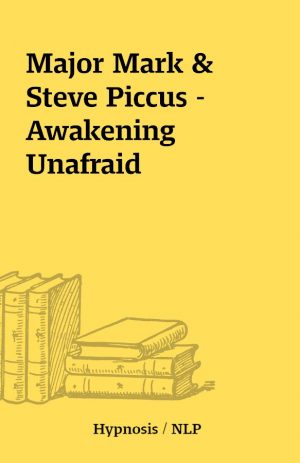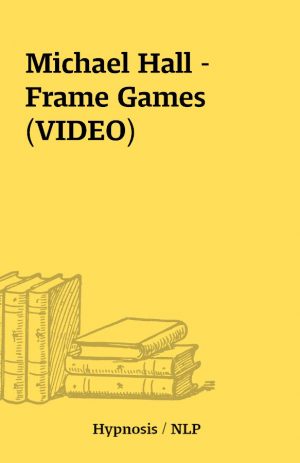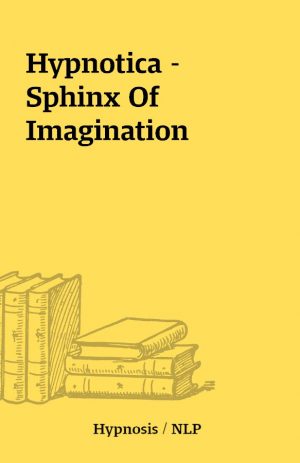Olivier Corchia – Modeling of Robert Dilts
Olivier Conchia – Modeling of Robert Dilts
[5 DVDs – MPEG]
Description
This is a program about modelling. Be warned that there is some translation occurring. It makes it appear that the sound track doesn’t match the video track. I haven’t watched the entire set, so I can’t give much more information about it. I thought it would be of interest to Robert Dilts fans.Here is the explanation from Olivier Corchia’s website, http://www.oliviercorchia.fr/en/presse.htm :Olivier Corchia : « Modeling is to me a most personal joy, as is sharing these modeling discoveries. On March 14, 2005, I had the good fortune to model a most fascinating subject : Robert DILTS; on a truly essential point : his quality of being in relation. It is my belief that on that day, NLP entered a new definition, that of focusing on modeling integrity and love. The result is so defining, that I feel compelled to share it with the entire NLP community- and of course with anyone interested beyond that community.This life experience is an invitation to all of us to promote modeling. Continuing modeling Robert DILTS, of course, for it was only a first step, and it brings as well as anchors wonderful qualities of being. To all of you, wherever you might be in the world, you are surrounded by beautiful people who have developped remarkable qualities of being, unusual know-howor magnificent skills. It is time for you to take the time, to focus on these people, not only on their capabilities, to be able to get deeply inspired by them and share that inspiration. Also, throughout the world, NLP schools can lead the way to the modeling of quality of being, thus truly entering 3rd Generation NLP.5 DVDs contain : whole modelisation day including 3 modelisation phases, keypoints synthesis, models developpements possibilities, public questions and reactions.NLP in evolution : Robert DILTS’ quality of being in relation. I have been practicing NLP for 10 years now, with passion, training in organizations, coaching and/or teaching at all levels of NLP within renowned NLP institutions. I take special personal delight in modeling and applying modeling to others. On March 14th 2005, I was given the pleasure of experiencing with a most captivating “model”: Robert Dilts; and a fundamental issue: his quality of being in relation .The result is so moving that I really believe it essential to share with the whole NLP Community and, of course, with anyone who desires so beyond that community.——————————————————————————–How This Modeling Came About :My interest for NLP is deeply rooted in the fact that – besides being efficient – it is generative and evolutionary. NLP allows us to create and find new possibilities, through its open-mindedness, especially by modeling.NLP already belongs to a certain tradition, which stems from multiple sources. Theoretical sources (Gregory BATESON, Noam CHOMSKY, Paul WATZLAWICK…) and empirical sources including the modeling of Virginia SATIR, Fritz PERLS and Milton ERICKSON by Richard Bandler and John Grinder, the original co-creators of NLP.NLP also fits into modernity – there have been many new developments in NLP- particularly with the in-depth work of Robert Dilts on NLP tools (SOAR and SCORE models, Neuro-Logical Levels, Beliefs Systems, Systemic NLP…), on NLP applications (health, leadership, therapy, learning…) and in terms of structure and popularization of NLP ( Modeling Geniuses, NLP Encyclopedia…).It is within the framework of these new developments in NLP that our day took place, modeling Robert Dilts on his quality of being in relation.In Montreal, before an audience of more than 100 people gathered there, thanks to the Centre Québécois de PNL and its director, Joanne Riou, we were able to take the time not to listen to Robert Dilts on a given topic, not to apply NLP exercises, but rather to respectfully look upon the “container”, the spirit and the soul of this man who has been contributing to NLP for 30 years now.In fact, what I wanted from this day was to focus on the quality of being, more so than on Robert’s efficient strategies and behaviors. For two fundamental reasons:- firstly, if I focus on the differences that make a difference in a successful helping relationship, I observe that efficiency and quality of being in relation are inseparable. NLP has mainly modeled efficient strategies and behaviors; therefore, it would have been of less value to decide on modeling tools or strategies again, which presented the actual risk of missing the essence of competency.- then, we all rub elbows with highly efficient environments and people, people of excellence, our society itself produces efficiency and excellence. What do we need today? Only a little more excellence? NLP can continue to bring more value, in an authentic and unique way, by allowing us to open to other insights. What inspiration guides Robert through his interventions, for instance, seemed to be just as fascinating as which direction his eyes take.How did we proceed?Our modeling consisted of exploring Robert’s quality of being through three examples.Our first example was a significant case that Robert chose. He described what he did to establish relationship in a situation in which getting rapport was not easy. From the very beginning, Robert took us into a deeper dimension – and I followed along – then inviting him, with questions, to explore even further his own awareness about his quality of being.For our second example, we watched a videotaped intervention of Robert coaching someone during the 3-day seminar entitled “Systemic Tools for a World in Transformation” that he had given prior to the Modeling Day. At this point, with Robert, we co-modeled the intervention’s key points, stopping the tape and reflecting upon how and why Robert responded or acted the way he did.Finally, our third example was simply the actual interaction between Robert and myself. Robert coached me to be in “his shoes” while I interacted with another person. I explored Robert’s quality of being by starting to integrate the patterns we had discovered and exploring further, in a wider way, questions that were necessary for me to understand this quality of being. Following this, we asked the participants to try out the key patterns that had come from our exploration. To be able to observe a model is itself very enriching, and to touch the model’s structure deeply heightens the experience. Therefore, after formally defining Robert’s process with the neuro-logical levels, we asked participants to work on specifically integrating this modeling “into the muscle” by doing several exercises.Such integration is essential even if it is sometimes underestimated in modeling/ transmission processes. It is necessary, for it allows us to start to practice the modeled “subject” in a different way. It also allows the person to adapt it to his/her own needs, to integrate what will make sense to him/her, through him/her. The purpose of this modeling is to contribute to the growth of a culture (that of the quality of being in relation) rather than to honor a cult (the cult of Robert Dilts).So, what were the results??This meeting with Robert proved to be a magical moment which has opened – I am deeply convinced of it – true pathways for those who wish to develop a deeper quality of being within their coaching or their life. These ways are numerous and rich, and I personally wish to offer them to you as an extension to the NLP presuppositions.I am aware how difficult this could prove, for I know so well how attached NLP followers are to these presuppositions! I wish that all of the NLP “Custodians of the Temple” open their vision through their conscience and heart, in examining the following new presuppositions.I remember how spaces opened to me when I discovered and applied the Basic Principles of NLP, and I imagine that it could be so with the following.What follows could, in fact, constitute some basic research on Third Generation NLP Presuppositions (1).A new presupposition which complements “The Map is Not the Territory”« Anyone can reach the territory »Although this sentence might resemble an « earthquake », it could prove fundamentally useful in transforming a person’s issues (as it was for some of the participants in the modeling program, working on Truth).This presupposition is possible through what I see as a complementary and opposite movement of the process described by NLP’s creators. Rather than selecting data, this movement consists of connecting to the field (mentioned by Gregory Bateson, for instance (2)), a kind of unfocusing of all 5 senses (VAKOG in NLP). Instead of distortion, one has to take the information as is, letting it go directly into our place of truth, our center of resources, somewhere slightly above the solar plexus. Instead of data generalizations, this data is processed in the here and now, that is in this location with this presence.This process, which exists in relation to others, most certainly requires – even for experienced communicators – a « re-learning », and regular practice to allow it to become unconscious.A new presupposition which could complement « People have a positive intention » :« A person’s identity is beautiful and paradoxical »To see, to accept and to sponsor this identity is so much more powerful than to recognize its positive intention.It is in the present paradox, deep inside the identity of the person that we can recognize the wholeness of this person.If this presupposition is self-evident to you, then it is important to promote it for its usefulness, just as with the positive intention.Two more presuppositions can complement a Third Generation NLP approach. « To be in a deep relationship with myself and with the person allows me to see and promote the beauty within that person »Deep synchronization does not only take place at the behavioral level (verbal and non-verbal), but is also located in a relationship at a somatic/emotional/energetic level, allowing a subtle resonance. This also requires one to try to see the person unconditionally where he/she is, and to recognize that space in him/her with love.« Body and Mind are linked to a larger Field »(There already is a presupposition stating that « body and mind are aspects of a same cybernetic system », and therefore influence each other)By integrating this new presupposition, we can access the field as a therapeutic tool, as a resource. It is interesting to take note of participants’ testimonies following that day, regarding its “energizing” power for the coach, when coaching with the field dimension.A few notes on my own experience and realizations through this modeling…Robert Dilts’ experience provided us with numerous pearls of teaching. Here are but a few: (I can not recopy everything and at this point in time, a DVD that will allow you to access this day and its teachings is still in production.I believe that some of our discoveries could be formally presented as Basic Principles for Communicating with Integrity and Sponsorship, in an NLP intervention, for instance :Start from your center and be « with Truth » (which requires one to « ground oneself », to take root, to connect with one’s emotional center).Indeed, this modeling’s first surprise for Robert was the presence, within himself, of a place of truth. A place where – when facing challenges, critics – Robert steps away from judgment and construction to feel what is, from his center.See the person and find out where he/she is (throwing little emotional “lines”, calibrating the other’s presence, in the voice frequency.)Sponsor the space where the person is. Give it energy, an energy that embraces, with affection. As if we were “caressing” the person (with intention) while also giving sponsoring messages (You have value…).Enter in this “subtle” center-to-center resonance.Create a field for this intervention, sponsoring the environment as well, and offering this space to the other person. Robert suggests having the intention of creating a “sacred space”.Maintain your own center, the sponsoring, of the client’s center, and the connection to the field all throughout the intervention.We could also point out other ways to develop new skills for certified Master Practitioners or “helping relationships” students.They highlight the ability to self-calibrate (like a tangible definition of integrity), the ability to connect to the other person when –that person does not want to be seen, the possibility to get to the voice’s essence, to talk to this voice at different places of the person (head, center) and even the ability to calibrate life.All these things are so essential – while rather basic in their explanation – and were made possible by tangible insights which occurred from what modeling Robert Dilts’ quality of being has revealed.The one startling question that emerges following this modeling is : “Finally, what do we pay attention to in order to improve our ability to live and to accompany others?”In conclusion…Despite my knowing Robert and his teachings, and despite my preparing for this modeling exercise, I approached it with genuine curiosity in order to discover Robert’s deeper talents. I discovered a much more emotional NLP than the one I learned. (Imagine that emotion was even a key element in Robert’s memory strategies and guiding exercises?)I discovered, as a watermark, an NLP within a spiritual dimension – with no proselytizing from its author – but directly embodied in the quality of his accompaniment. I discovered words of Truth and of Beauty, which resonated as a more than positive intention within the relationship…That NLP, I loved, for it took me away from suspicions and unfounded accusations of power and manipulation by its critics. By modeling Robert’s quality of being in relation, surely we have found what already existed within Virginia Satir, Gregory Bateson or Milton Erickson…We also reached beyond the work of NLP’s creators, Richard Bandler and John Grinder : NLP now extends further than the modeling of excellence.I believe that on March 14th, 2005, NLP entered a new definition – the attention to modeling integrity and love.This true experience is an invitation for us all to promote modeling. To carry on Robert Dilts’modeling, of course, because it is just starting and bringing and anchoring very beautiful qualities of being. To you all, wherever you are in the world, around you are persons who have developed a beautiful quality of being, a rare experience, a wonderful talent. It is time to take the time to put your attention on them—and not only on their capacities, to be able to profoundly be inspired and to share this with others.Also all around the world, NLP Institutes can be true leaders in opening this path of modeling the quality of being and so concretely enter into the Third Generation NLP.Olivier CorchiaCertified NLP TrainerCoach & Business Consultant
You must be logged in to post a review.






Reviews
There are no reviews yet.